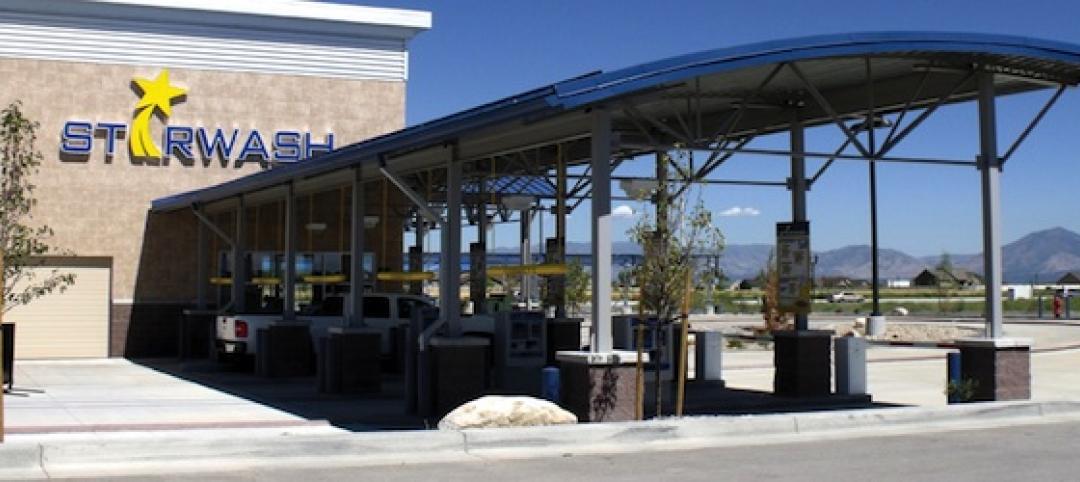GKD’s new Solar Omega stainless steel metal fabric panels are geared for sun shading.
As the sun rises higher in the sky, the stacking effects of the horizontal metal rods shade the building façade. As the sun descends, more daylight is allowed through the mesh. Options include deeper horizontal rods, which increase the amount of shading while maintaining views through the fabric, and the ability to vary the open area based on the unique solar needs of the project.

Flexible and rigid versions are available.
Related Stories
| Sep 13, 2010
7 Ways to Economize on Steel Buildings
Two veteran structural engineers give you the lowdown on how to trim costs the next time you build with steel.
| Sep 13, 2010
Community college police, parking structure targets LEED Platinum
The San Diego Community College District's $1.555 billion construction program continues with groundbreaking for a 6,000-sf police substation and an 828-space, four-story parking structure at San Diego Miramar College.
| Sep 13, 2010
Campus housing fosters community connection
A 600,000-sf complex on the University of Washington's Seattle campus will include four residence halls for 1,650 students and a 100-seat cafe, 8,000-sf grocery store, and conference center with 200-seat auditorium for both student and community use.
| Sep 13, 2010
Second Time Around
A Building Team preserves the historic facade of a Broadway theater en route to creating the first green playhouse on the Great White Way.
| Sep 13, 2010
China's largest single-phase hospital planned for Shanghai
RTKL's Los Angles office is designing the Shanghai Changzheng New Pudong Hospital, which will be the largest new hospital built in China in a single phase.
| Sep 13, 2010
Data Centers Keeping Energy, Security in Check
Power consumption for data centers doubled from 2000 and 2006, and it is anticipated to double again by 2011, making these mission-critical facilities the nation's largest commercial user of electric power. With major technology companies investing heavily in new data centers, it's no wonder Building Teams see these mission-critical facilities as a golden opportunity, and why they are working hard to keep energy costs at data centers in check.
| Aug 11, 2010
Average annual pay increases at A/E/P firms continue to rise in 2010
Despite the economic challenges that many architecture, engineering, planning(A/E/P) & environmental consulting firms have faced in recent years, a large majority of firms continue to include pay increases for their staff in their annual budgets, according to a new report released by ZweigWhite. According to ZweigWhite's 2010 Policies, Procedures, and Benefits Survey of Architecture, Engineering, Planning & Environmental Consulting Firms, the average pay increase that A/E/P firms project that they will provide in 2010 has increased from 2009. ZweigWhite, March 2
| Aug 11, 2010
ASHRAE Receives NIST Grant to Study IAQ in Retail Stores
The American Society of Heating Refrigeration and Air-conditioning Engineers (ASHRAE) has been awarded $1.5 million dollars in grant money from the National Institute of Standards and Technology (NIST) to conduct a three-year research project on ventilation and indoor air quality in retail stores.
| Aug 11, 2010
Georgia Tech requires LEED Gold for all new buildings and renovations
The Georgia Institute of Technology in Atlanta is currently updating its facilities design standards to meet LEED (Leadership in Energy and Environmental Design) Gold as set by the U.S. Green Building Council. Energy Ace, Inc., an Atlanta-based sustainability consulting firm is assisting Georgia Tech in preparing the Standards upgrade.
| Aug 11, 2010
UC Merced researchers receive $568,000 grant to develop solar sensing, tracking system
Alberto Cerpa, an engineering professor at the University of California Merced, has received a $568,202 grant from the National Science Foundation to develop a system that will measure and track the amount of sunlight that reaches ground level where photovoltaic panels and solar concentrators used in solar energy systems collect light and heat to turn into electricity.













